Background: Beak Trimming and Feather Pecking in Laying Hens
Injurious feather pecking is a major welfare problem in laying hens which can occur in all types of rearing systems, including free-range systems that have a higher welfare potential. In the most severe cases it can lead to cannibalism. In order to reduce the risk of feather pecking and cannibalism, hens are usually beak trimmed. This consists of amputating one third to a half of the bird’s beak using a red hot blade or infra-red beam. Beak trimming leads to tissue and nerve damage and is associated with acute pain, irrespective of the method used.
Insufficient opportunity to carry out foraging behaviour is widely accepted as a primary risk factor for feather pecking. However, the causes of this abnormal behaviour are multi-factorial with risk factors – including genetics, environment, health and management. It is therefore important to address them all in order to prevent injurious pecking and to successfully operate a laying hen rearing system without the need to beak trim.
The Rondeel system is a unique barn system, with many features in which the hens are not beak trimmed. This case study highlights the key features and management aspects of this system which make it possible to rear laying hens with beaks intact, without resulting in injurious feather pecking.
Overview of the Rondeel Barn System
Rondeel is an enriched barn system for laying hens, owned by the Dutch Venco Group. There are currently three Rondeel farms located in The Netherlands, and the system is also available for franchise. Rondeel eggs are mainly sold in Albert Heijn retail stores, at an intermediate price between free-range and organic.
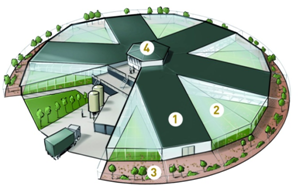
A Rondeel barn accommodates 30,000 birds and has a characteristic circular design split into 10 sub-units, each housing 3,000 hens (see illustration on the left).
Each unit is divided into three distinct areas in order to better address the hens’ behavioural and mental needs and give them the freedom to choose their environment.
The three distinct areas
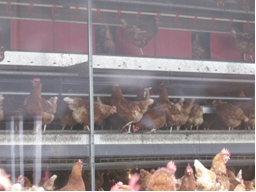
1. Multi-tiered night quarters with three separate levels for feeding, nesting and egg laying, and perching (see picture on the left). The bottom tier is composed of a layer of litter for scratching and dust-bathing. The second tier incorporates nesting boxes while the third tier provides aerial perches, allowing birds to feel safe whilst resting. Feeding stations are provided on the first and third tiers.
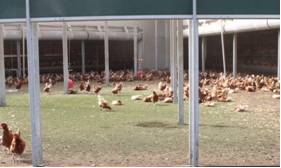
2. Spacious day quarters (or veranda – see picture on the right) which provide more space than is required by EU regulation – 6.7 birds/m² vs. 9 birds/m² – and natural light (transparent ceiling). This area is covered in artificial grass and grain is scattered every morning to encourage foraging. Dust bathing areas are provided with open-sided screens.
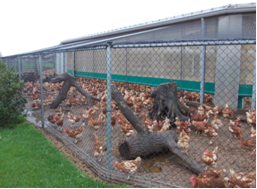
3. An enclosed outdoor area (see picture on the left) enriched with wood trunks and access to soil for dust bathing. When open, this area reduces the indoor stocking density to 5.2 birds/m², providing a very generous space allowance. The area is covered with netting to prevent wild birds from entering the system and spreading disease. Tree trunks have been provided to create opportunities for perching and hiding.
Keys to success: How Rondeel has managed to stop beak trimming
Housing features
Several features of the Rondeel barn design are key to preventing injurious pecking, including:
- A multi-tier system in the night quarters, which provides a more complex environment than a single-tier system, and is more similar to the chicken’s natural woodland habitat.
- Aerial perches help prevent feather pecking as they create opportunities for resting and refuge by enabling resting birds to avoid being pecked by foraging birds. They also avoid mixing active and inactive birds by providing distinct resting areas.
- Ranging opportunities - the whole length of the house can be opened for the birds to go outside. Ranging is encouraged in the day quarters by scattering grain daily and providing natural light in a fully covered area – allowing the hens to range while being protected from adverse weather. The provision of wood trunks and wood shavings and the presence of a sandy surface and drainage system to avoid puddles also help to increase the use of the outdoor run. Finally, the presence of drinking points in the day quarters, encourage the birds to range in this area. Increased use of the range is strongly associated with a reduced risk of feather pecking.
- Plenty of environmental enrichment with the provision of nesting boxes and aerial perches in the night quarters, dust bathing areas, artificial grass in the day quarters, wood trunks and wood shavings in the outside run. This diverse and interesting environment is important to allow the expression of a range of natural behaviours such as foraging, perching and dust bathing, which helps prevent injurious pecking.
- A lower stocking density gives the birds more space; 9 birds/m² in the night quarters, reducing to 6.7 birds/m² when the day quarters are open and down to 5.2 birds/m² when the outdoor run is also open.
- Provision of adequate litter in the night quarters, which has been shown to reduce the incidence of feather pecking. The artificial grass in the day quarters is also a unique addition which encourages the hens to scratch, peck, rest and range.
- Climate control, with sensors placed on the rolling doors that separate the day and night quarters, controlling the opening of the doors according to the temperature and creating a uniform climate between the day and night quarters, helps encourage the hens into the day quarters to range and forage.
- Reducing group size within the barn which is divided into 10 sub-groups. The risk of feather pecking is generally lower in hens that are kept in smaller groups than in larger flocks as they are able to establish stable social interactions.
Feeding regime and opportunities for foraging
- Daily scattering of grain, which provides an opportunity for natural foraging behaviour. Increasing the length of time the birds spend foraging and feeding is likely to reduce the incidence of feather pecking.
Genetics and breeding
- The use of the Lohmann Brown Lite breed, which seems to have a lower propensity to feather peck.
Key Learnings and Take Home Messages
As successfully demonstrated in the Rondeel barn system, it is possible to stop beak trimming without resulting in injurious feather pecking. This can be achieved with a good housing and feeding system, a varied environment, appropriate choice of genetics, good flock management and climate control.
Key aspects to successfully stop beak trimming and reduce the risk of feather pecking in a cage-free rearing system include:
- Creating opportunities for resting and refuge and avoiding mixing active and inactive birds, especially through the provision of aerial perches
- Providing ranging opportunities and encouraging the use of the range, especially through the provision of environmental enrichment and outdoor tree cover
- Increasing the length of time the birds spend engaged in foraging and feeding especially through the daily scattering of grain or feeding a high fibre, low-energy diet of mash rather than pellets
- Choosing appropriate strains of hens, less prone to feather pecking, such as the Lohman Brown Lite breed.
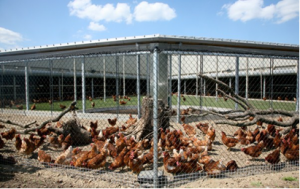
Early experiences during the rearing period (before laying) should also be considered as they have a significant impact on the future tendency of the hens to feather peck. Housing, feeding and management conditions during the rearing and laying periods should be matched as closely as possible to reduce the risk of feather pecking later in life.
To find out more
- For further information on beak trimming and reducing the risk of feather pecking in laying hens, you can consult our fully referenced technical resources:
- Our information sheet Reducing the need for beak trimming in laying hens
- Our report Controlling feather pecking and cannibalism in laying hens without beak trimming
- For a detailed practical guide to avoiding injurious pecking, see Bristol University’s management guide at: www.featherwel.org
- For more information on the Rondeel system, you can visit their website at: www.rondeeleieren.nl
- View our other Case Studies
